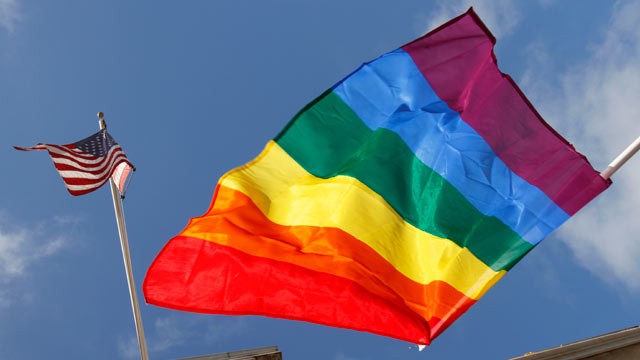For the second time in less than a year, the little French
mountain town is submerged in an unexpected and dangerous deluge. Dark, muddy
waters of the Gave de Pau roar around—and almost above—the rocky little grotto
where the Blessed Virgin appeared to Bernadette Soubirous.
These latest flash floods come just after the French
government let loose a different kind of flood—the legalization of gay
marriage. The same France Our Lady chose as a special site of healing is inundated
with a torrential wave of sickening relativism regarding love and marriage. The
meaning of marriage has been desecrated, and the French must now accept a
distorted form of lust as “marriage,” must not assert that this sacred bond
only belongs between one man and one woman. The voice of reason has been
drowned out. The destructive floods drowning Lourdes are not a consequence of
the political decision; but they are an apt sign of it.
In the United States, we are facing a similar flood. This
week, the Supreme Court will decide whether to legalize gay marriage. Disney
just okayed the first gay couple in its children’s TV shows. The Boy Scouts succumbed
to cultural pressures to approve open gays in their ranks. The Pew Research
Center just released a study revealing the striking media bias in favor of gay
marriage. In short, everywhere you look, the falsehood that homosexuality is
normal and praiseworthy and should be revered as socially acceptable as
“marriage” is emblazoned across our newspapers and computer screens, proclaimed
aloud from secular pulpits and flaunted with arrogant “pride” in our streets. The
high tide of support for the gay agenda is overwhelming.
It is tempting to feel that our society will be swept away
in this deluge: that the waters pounding about our ears will push down and wipe
out our social sanity—a cultural Katrina for our country. But in the midst of this rising tide, and thinking
of the waters rising round our Lady’s feet at Lourdes in the wake of France’s
sad new decision, we ought to remember another flood—a flood strangely connected
by symbol to the one which we face now: the flood of Noah.
There is, perhaps, no little irony in the fact that the flag
chosen by those who push gay rights was once chosen by God as a promise of hope
to mankind: a rainbow. The emblem which,
for them, proclaims allegiance to a barren and self-destructive act, was once
the herald of new life and fruitfulness for the scion of humanity stepping off
the ark onto new ground. It was the promise of God that He would never flood the
whole earth again.
It once proclaimed the end of the flood; now it proclaims
its coming.
And yet, now, when the rainbow is a banner over the tide of
those forcing their redefinition of love and marriage down our throats, there
is a new and subtler significance in the symbol. Noah’s stolen rainbow cannot be fully
usurped. It remains for us, even now, a sign of hope. Even as they wave it in our faces as a
proclamation of their hellish new world, where sin calls itself love and
authentic love is labeled hate, we see it and are reminded of its original
meaning. It is still a promise. God does not and will not abandon us. There is
hope amidst the flood.
 Which brings us back to Lourdes. I visited Lourdes a mere
week and a half after the murky floodwaters of last October swirled over the spot
the Blessed Virgin chose for a sacred stream. Even as I arrived, the waters
streamed from the sky in bitterly cold, torrential rains.
Which brings us back to Lourdes. I visited Lourdes a mere
week and a half after the murky floodwaters of last October swirled over the spot
the Blessed Virgin chose for a sacred stream. Even as I arrived, the waters
streamed from the sky in bitterly cold, torrential rains.
But that did not stop the faithful. In the freezing mountain
rain and mist, pilgrims still gathered for the evening candlelight rosary
procession outside the basilica. My glasses fogging in the cold, my jeans
soaked through from the icy puddles pooling up at the altar of the snow-white
Virgin, I was deeply moved by the incredible devotion of the many pilgrims who
had gathered to pray. The floods had passed, and the faithful prayed on.
The waters of this
cultural tide will leave wreckage and havoc in their wake. As if to remind us
of God’s promise that the waters will not overwhelm us, a rainbow shines out in
the very center of the battle, giving
us hope even from our attackers. And while the waters still roar about us, when
our prayers are lifted in hope, we ought to remember another promise, to the
man who prays to God in time of distress: “The floodwaters may reach high, but
him they shall not reach” (Psalm 32:6). Just as for the faithful at Lourdes,
these waters will pass, and our prayers will continue. The clouds will break.
The waters will subside. And God’s promise will shine in sky, untarnished—still
our symbol of hope.
 |
| Gave de Pau in Lourdes |





